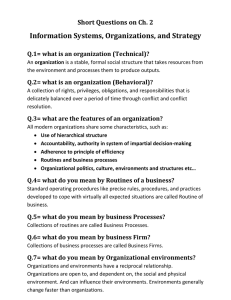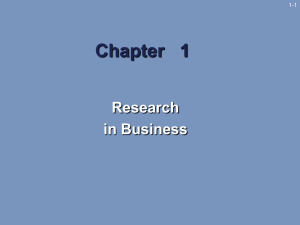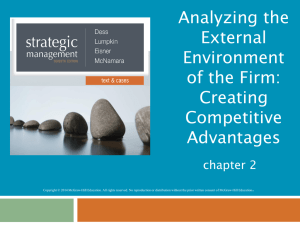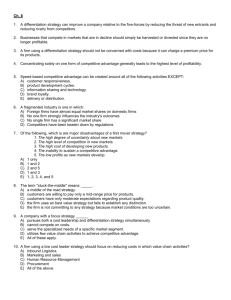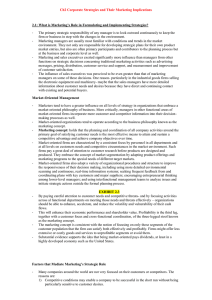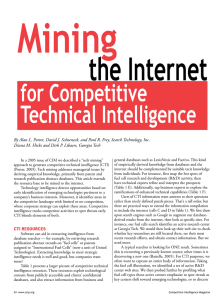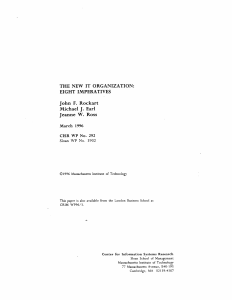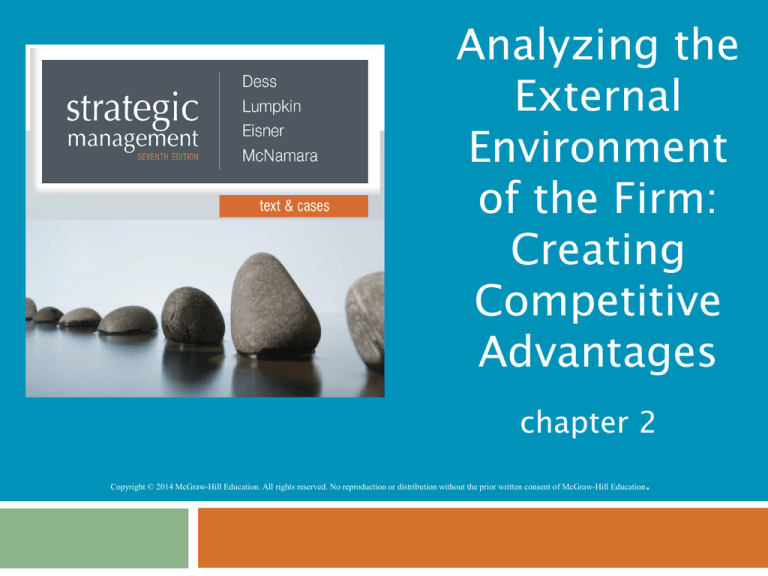
Analyzing the
External
Environment
of the Firm:
Creating
Competitive
Advantages
chapter 2
Copyright © 2014 McGraw-Hill Education. All rights reserved. No reproduction or distribution without the prior written consent of McGraw-Hill Education
.
Creating the Environmentally
Aware Organization
2-2
Exhibit 2.1 Inputs to Forecasting
Environmental Scanning &
Monitoring
2-3
Environmental scanning involves
surveillance of a firm’s external
environment
Predicts
environmental changes to come
Detects changes already under way
Allows firm to be proactive
Environmental monitoring tracks evolution
of environmental trends
Hard
trends – measurable facts/events
Soft trends – estimated, probable events
Competitive Intelligence
2-4
Competitive intelligence
Helps
firms define & understand their industry
Identify rivals’ strengths & weaknesses
Collect
data on competitors
Interpret intelligence data
Helps
firms avoid surprises
Anticipate
competitors’ moves
Decrease response time
Beware
of the potential for unethical behavior
while gathering intelligence
Environmental Forecasting
2-5
Environmental forecasting predicts change
Plausible
projections about
Direction
of environmental change?
Scope of environmental change?
Speed of environmental change?
Intensity of environmental change?
Scenario analysis involves detailed
assessments of the ways trends may affect
an issue & development of alternative
futures based on these assessments
SWOT Analysis
2-6
SWOT analysis is a basic technique for
analyzing firm and industry conditions
Firm
or internal conditions = Strengths &
Weaknesses
Where
the firm excels or where it may be lacking
Environmental
or external conditions =
Opportunities & Threats
Developments
that exist in the general
environment
Activities among firms competing for the same
customers
The General Environment
2-7
The general environment is composed of
factors that are both hard to predict and
difficult to control:
Demographic
Sociocultural
Political/Legal
Technological
Economic
Global
The Competitive Environment
2-8
The competitive environment consists of
factors in the task or industry
environment that are particularly relevant
to a firm’s strategy:
Competitors
(existing or potential)
Including
those considering entry into an entirely
new industry
Customers
(or buyers)
Suppliers
Including
those considering forward integration
Porter’s Five-Forces Model of
Industry Competition
2-9
Exhibit 2.4 Porter’s Five-Forces Model of Industry Competition
Source: Adapted and reprinted with permission of The Free Press, a division of Simon & Schuster Adult Publishing
Group, from Competitive Strategy: Techniques for Analyzing Industries and Competitors by Michael E. Porter.
Copyright © 1980, 1998 by The Free Press. All rights reserved.
How the Internet and Digital
Technologies Affect Competitive Forces
2-10
Using Industry Analysis: A Few
Caveats
2-11
Managers must not always avoid low profit
industries – these can still yield high returns for
players who pursue sound strategies
Five forces analysis implicitly assumes a zerosum game – yet mutually beneficial relationships
can still be established with buyers & suppliers
Five forces analysis is essentially a static analysis
– yet external forces can still change the
structure of all industries
See the value net
Vertical dimension = suppliers & customers
Horizontal dimension = substitutes & complements
The Value Net
2-12
Exhibit 2.6 The Value Net
Source: reprinted by permission of Harvard Business Review. Exhibit from “The Right Game: Use Game Theory to
Shape Strategy,” by A. Brandenburger and B.J. Nalebuff, July-August 1995. Copyright © 1995 by the Harvard
Business School Publishing Corporation. All rights reserved.
Strategic Groups Within Industries
2-13
Two unassailable assumptions in industry
analysis:
No
two firms are totally different
No two firms are exactly the same
Strategic groups – clusters of firms that
share similar strategies:
Breadth
of product & geographic scope
Price/quality
Degree of vertical integration
Type of distribution
Strategic Groups Within Industries
2-14
Exhibit 2.7 The World Automobile Industry: Strategic Groups
Note: Members of each strategic group are not exhaustive, only illustrative.
Strategic Groups Within Industries
2-15
Strategic groups as an analytical tool
Helps
identify barriers to mobility that
protect a group from attacks by other groups
Helps identify groups whose competitive
position may be marginal or tenuous
Helps chart the future direction of firms’
strategies
Helps to think through the implications of
each industry trend for the strategic group as
a whole

